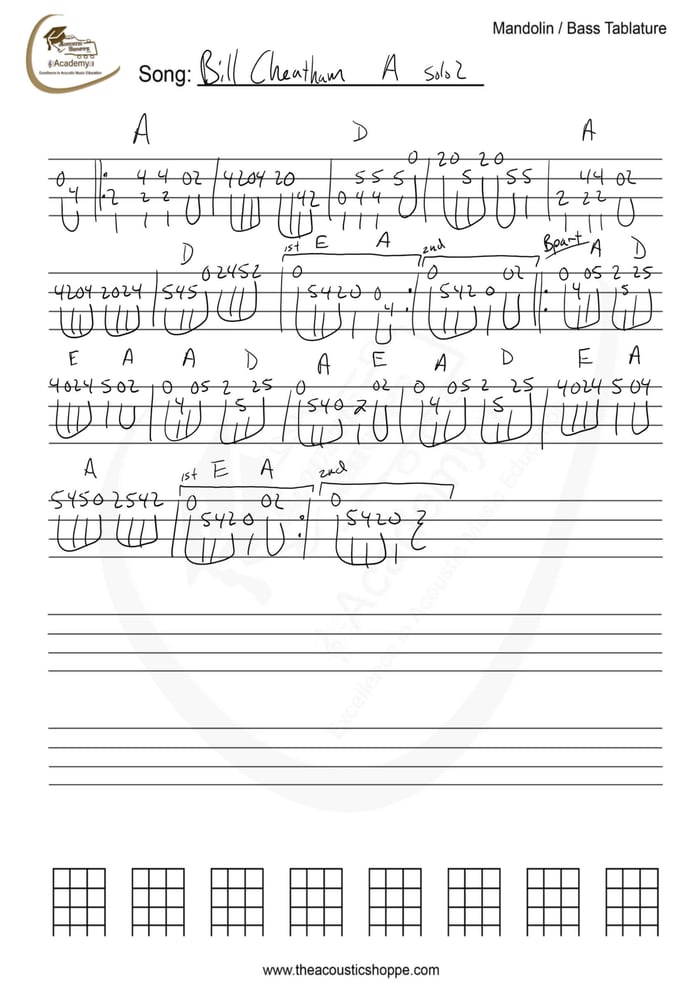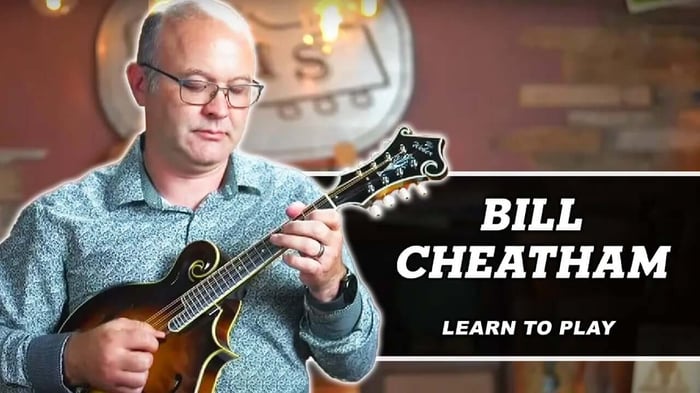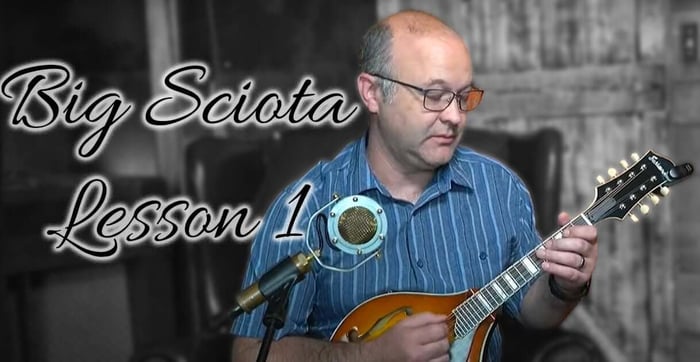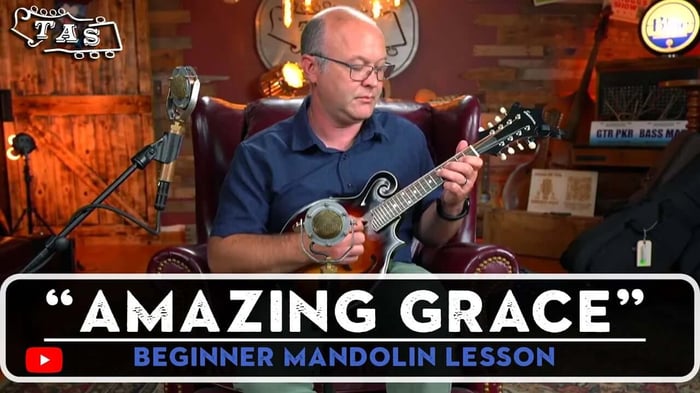Your Free Lesson: Mastering "Bill Cheatham" on Mandolin
Welcome back to another free mandolin lesson here at The Acoustic Shoppe! Today, we're diving into a true classic that every mandolin player should know: "Bill Cheatham." Acoustic Shoppe co-owner, Jeremy Chapman has put together an intermediate arrangement in the key of A that incorporates powerful double-stops right into the main melody of the 'A' part. It gives the tune that authentic, bouncy sound, which you'll find fun to play.
This classic fiddle tune is a tune known for its energetic rhythm and memorable melody, making it a favorite at jam sessions and a great vehicle for exploring new techniques on your mandolin. This lesson is designed to help you navigate its intricacies, from the fundamental melody to those crucial double-stops that add so much depth and punch.
Whether you're looking to expand your soloing vocabulary, improve your timing, or simply add another classic tune to your repertoire, this free mandolin lesson is for you. Jeremy breaks it down step-by-step, ensuring you understand not just the notes, but the feel and essence of this iconic tune.
Link to Tablature down below
The Enduring Legacy of "Bill Cheatham": A Fiddle Tune with Deep Roots
"Bill Cheatham" feels like one of those tunes that has always been around, a foundational piece in the tapestry of American traditional music. While its exact origins are somewhat unclear, it's widely regarded as an old-time fiddle tune that has seamlessly transitioned into the bluegrass canon. Its rhythmic drive and adaptable melody have ensured its longevity and widespread appeal.
The Mystery of "Bill Cheatham"
The true identity of "Bill Cheatham" remains a subject of speculation and folklore among musicians and music historians. There are several prevailing theories about who the namesake might have been:
A Civil War Figure: One popular theory suggests that "Bill Cheatham" refers to a historical figure from the American Civil War. Some accounts link the tune to William Cheatham, a soldier from Tennessee or North Carolina. However, concrete evidence directly connecting him to the tune is elusive.
A Local Character: Another possibility is that Bill Cheatham was simply a colorful local character, perhaps a fiddler, dancer, or even an individual known in the Appalachian region where many of these tunes originated. Many old-time tunes were named after individuals, places, or events, often without detailed historical records.
Regardless of the precise origins of its name, this melody was firmly established in the repertoire of early American fiddlers. It was a common tune played at dances, hoedowns, and social gatherings, contributing to its organic spread across the country.
From Old-Time to Bluegrass Staple
"Bill Cheatham" made a natural leap from the old-time tradition into the burgeoning world of bluegrass music. Its inherent drive and clear melodic structure made it perfectly suited for the faster tempos and improvisational nature of bluegrass.
Early Recordings: The tune appeared on early 78 RPM records, contributing to its dissemination. While it's difficult to pinpoint the very first recording, it was certainly being played and recorded by prominent old-time and early country musicians by the 1920s and '30s.
Bluegrass Adoption: As bluegrass evolved, mandolin players, banjo players, and guitarists embraced "Bill Cheatham" as a vehicle for demonstrating their virtuosity. Its 'A' part's rhythmic nature and the more melodic 'B' part offer distinct opportunities for different picking styles and melodic interpretation.
Notable Performances: While not exclusively tied to one artist, "Bill Cheatham" has been performed and recorded by nearly every major bluegrass artist at some point, solidifying its place as a jam session standard. Its adaptability allows for endless variations, from driving bluegrass breaks to more intricate melodic arrangements. There are examples, including the recording by Flatt & Scruggs with Doc Watson, where the solos start on the “B” part.
The journey of "Bill Cheatham" from an obscure old-time tune to a universally recognized staple highlights the interconnectedness and evolution of traditional American music. It's a testament to the power of a good melody and rhythm to transcend generations and genres.
Key Takeaways from This Lesson: Unlocking "Bill Cheatham" on Mandolin
Jeremy Chapman's arrangement in the key of A is packed with essential mandolin techniques. Here are the core takeaways to focus on as you practice:
The Power of Double-Stops: The 'A' part of this arrangement heavily features double-stops. Jeremy demonstrates how to integrate these into the melody, adding fullness and drive. Pay close attention to the precise finger placement and pick stroke required to make both notes ring clearly. This is a hallmark of strong bluegrass mandolin playing.
Fingering in the Key of A: While "Bill Cheatham" is often played in G or D on the fiddle, playing it in A on the mandolin requires comfortable navigation of the A major scale and arpeggios. Focus on efficient finger transitions, and take advantage of leaving fingers down that you will be returning to within a few notes.
Rhythmic Drive: "Bill Cheatham" is known for its driving, energetic feel. Emphasize a strong, consistent downstroke on the off-beat (2nd and 4th) and experiment with spacing of the notes to create a “Hornpipe” like lilt.
The Contrast Between A and B Parts: Notice the melodic and rhythmic contrast between the 'A' and 'B' parts. The 'A' part is often more rhythmic and chord-based, while the 'B' part tends to be more melodic and flowing. This contrast is crucial for a dynamic and interesting solo.
Practice with a Metronome: As always, start slow! Use a metronome to build consistency and accuracy, especially with the double-stops and faster passages. Gradually increase the tempo only when you can play the entire solo cleanly at your current speed.
Listening is Key: Listen to various recordings of "Bill Cheatham" by different artists – both old-time fiddlers and bluegrass mandolinists. This will help you internalize the feel of the tune and inspire your own interpretations. Check out our Spotify playlist, Acoustic Shoppe Mandolin Sessions, for some great examples of this tune.
Mandolin TAB/Chord Chart for "Bill Cheatham" (Key of A)
To help you practice Jeremy Chapman's intermediate arrangement, here is the full tablature. This includes the double-stops in the 'A' part as taught in the video.
Download a high-quality PDF version of the TAB here!

Practice Tips for Success
Mastering an intermediate tune like "Bill Cheatham" with double-stops requires focused and consistent practice. Here are some actionable tips to help you succeed:
Break It Down: Don't try to learn the entire tune at once. Focus on one phrase or measure at a time. Master that small section before moving on. Pay particular attention to the transitions between phrases.
Isolate the Double-Stops: The double-stops in the 'A' part are crucial to this arrangement's sound. Practice them slowly and deliberately until each note rings out clearly and you can transition smoothly into and out of them. Ensure your pick attack is consistent for both notes.
Slow and Steady: Begin practicing at a very slow tempo (e.g., 60-80 BPM) using a metronome. Focus on precision and clean execution. Only increase the speed gradually when you can play the entire section flawlessly several times in a row.
Record Yourself: Use your phone to record your practice sessions. Listening back objectively can highlight areas where your timing is off, notes are unclear, or dynamics are lacking. It's a powerful self-correction tool.
Alternate Picking Consistency: Strive for consistent alternate picking (down-up-down-up) throughout the tune, with single down-strokes for the quarter notes. This provides a smooth, driving sound and helps build speed and endurance.
Listen Actively: Immerse yourself in recordings of "Bill Cheatham." Listen to how different musicians interpret the tune, focusing on their rhythm, dynamics, and ornamentation. This will not only improve your understanding of the tune but also inspire your own musicality.
Regular, Shorter Sessions: It's more effective to practice for 30 minutes consistently every day than to have one marathon 3-hour session once a week. Regularity builds muscle memory and reinforces learning.
Practice with a Backing Track: Once you're comfortable with the solo, try playing along with a backing track. This helps you develop your timing in a musical context and prepares you for playing with other musicians. Search for "Bill Cheatham backing track A major" on YouTube or use a jam track app. Play along with this video and practice the transition between solo and back-up rhythm.
Gear Used in This Lesson
In this video, Jeremy Chapman is showcasing a beautiful Weber mandolin that truly brings out the clarity and punch required for a tune like "Bill Cheatham."
Jeremy is playing a Weber Yellowstone, which is an excellent choice for players looking for a high-quality F-style mandolin with a strong, articulate voice perfect for bluegrass and old-time music. Its hand-carved solid spruce top and solid maple back and sides contribute to its powerful projection and rich tone.
For strings, he's using a set of D'Addario EJ74 Phosphor Bronze Medium Mandolin Strings. These are a popular choice among mandolinists for their balanced tone, excellent projection, and long-lasting quality, providing the crispness needed for those double-stops.
The pick he is using is a ToneSlabs Darth Tone Series *Jeremy Chapman* Signature XL Tri Corner Guitar Pick - 1.3 mm. ToneSlabs picks are renowned for their exceptional tone, glide, and beveled edge, allowing for effortless picking and enhanced articulation, crucial for precise playing on tunes like "Bill Cheatham."
All of these high-quality acoustic music instruments and accessories are available right here at The Acoustic Shoppe, your trusted source for premium acoustic instruments.
Continue Your Journey with Free Acoustic Shoppe Mandolin Sessions Lessons!
Congratulations on tackling "Bill Cheatham"! This tune is a fantastic addition to your mandolin repertoire and a great way to improve your rhythmic precision and double-stop technique.
Ready for more? You can find this lesson and all of our other free mandolin lessons here on our ultimate guide to free mandolin lessons. We are constantly adding new content to help you on your mandolin journey, so be sure to check back often! From beginner basics to advanced techniques, The Acoustic Shoppe is your home for quality mandolin lessons and all things acoustic music.
About Your Instructor: Jeremy Chapman
Jeremy Chapman is a lifelong musician with deep roots in acoustic music. For over 25 years, he performed nationally with his family's acclaimed bluegrass band, The Chapmans, a journey that included performances on the legendary Grand Ole Opry stage. Beyond the stage, Jeremy has dedicated two decades to teaching private mandolin lessons, sharing his passion and expertise with aspiring players. He is also the author of the highly-regarded Do-It-Yourself Mandolin book, published by Hal Leonard, praised for its clear, step-by-step approach. Today, Jeremy serves as the President and CEO of The Acoustic Shoppe, continuing his mission to foster musical growth and provide quality instruments to the acoustic community.





